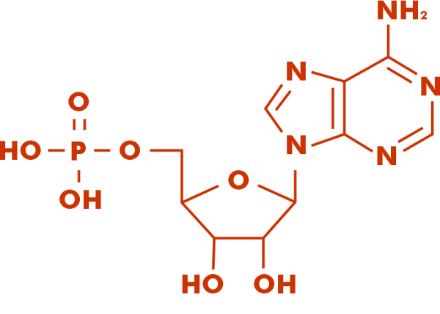What is the Full Form of AMPAMP: Adenosine MonophosphateAMP stands for Adenosine Monophosphate (AMP); in other words, in Organic Chemistry, it is also known as 5'-Adenylic Acid, a type of Nucleotide. Adenosine Monophosphate (AMP) consists of a Sugar Ribose, a Nucleobase Adenine, and a Phosphate group. Adenosine Monophosphate is an ester of Nucleoside Adenosine and Phosphoric Acid. The other substituent, or we can say the prefix for Adenosine Monophosphate, is Adenylyl. Names for Adenosine Monophosphate (AMP)The IUPAC (International Union of Pure and Applied Chemistry) name for Adenosine Monophosphate (AMP) is Adenosine 5'-(dihydrogen phosphate), but the preferred IUPAC (International Union of Pure and Applied Chemistry) name for Adenosine Monophosphate is [(2R,3S,4R,5R)-5-(6-Amino-9H-Purin-9-yl)-3,4-dihydroxyoxolan-2-yl] methyl dihydrogen phosphate, the other names for Adenosine Monophosphate is Adenosine-5'-monophosphate, 5'-Adenylic Acid. Properties of Adenosine Monophosphate (AMP)The Chemical formula for denoting Adenosine Monophosphate is C10 H14 N5 O7 P, and the molar mass of Adenosine Monophosphate is 347.22 grams per mole. If we see this compound with the help of a powerful microscope, it would appear as a White Crystalline powder. The density of Adenosine Monophosphate, when calculated with the chemical equations, comes out to be 2.32 grams per ml. The Boiling point of Adenosine Monophosphate is 798.5 degrees Celsius (1469.3 degrees Fahrenheit and 1071.7 kelvin), and this compound's melting point is 178 to 185 degrees Celsius (351.5 to36.5 degrees Fahrenheit; 451 to 458 Kelvin). The Ph value of Adenosine Monophosphate is less than seven, which means it is an acidic compound with a Ph value of 0.9 [citation needed], 3.8, 6.1. In many metabolic processes, Adenosine Monophosphate plays a vital role in the human body. It is also converted into several molecules like ADP (Adenosine Di Phosphate) and ATP (Adenosine Tri Phosphate), which is the storehouse of power in the human body. During the synthesis of the RNA molecule, the AMP (Adenosine Monophosphate) plays a vital role in its formation. This molecule is present in all forms of living beings. 
Production or Formation of AMPAdenosine Monophosphate did not have the high energy phosphoanhydride bond associated with ATP (Adenosine Tri Phosphate) and ADP (Adenosine Di Phosphate). ADP (Adenosine Di Phosphate) is also responsible for forming AMP (Adenosine Monophosphate). 2ADP -> ATP + AMP The Adenosine Monophosphate can also be produced by the complete hydrolysis of high energy phosphate bond of Adenosine Di Phosphate. ADP + H2O -> Pi + AMP By doing the complete hydrolysis of ATP (Adenosine Tri Phosphate) into pyrophosphate and AMP (Adenosine Monophosphate) in this way, the Adenosine Monophosphate is formed chemically. It can be represented as ATP + H2O -> AMP + PPi Adenosine Monophosphate and nucleoside monophosphate are some molecules formed when the different enzymes of the living body break the RNA. Degradation of AMPThe Adenosine Monophosphate is further decomposed into the ATP (Adenosine Tri Phosphate) AMP + ATP -> 2 ADP (Adenylate kinase in the opposite direction) ADP + Pi -> ATP (this step is usually performed in aerobes by forming ATP while Oxidative phosphorylation), further the conversion of Adenosine Monophosphate into IMP by Myoadenylate deaminase, freeing an ammonia group. In Catabolic processes, Adenosine Monophosphate (AMP) conversion to Uric Acid is done; this process is mainly done inside the mammal's body. Circular Adenosine MonophosphateAdenosine Monophosphate also exists in a cyclic structure called Cyclic Adenosine Monophosphate. In various cells inside the living body, the enzyme Adenylate cyclase forms the Cyclic Adenosine Monophosphate with the help of ATP (Adenosine Tri Phosphate). Various hormones like Glucagon regulate this reaction, or we can say Adrenaline. Cyclic Adenosine Monophosphate plays a vital role in intracellular signaling. Deficiency of Adenosine MonophosphateAdenosine Monophosphate deficiency causes problems in the muscle movement that is the Skeletal muscle. Generally, people who suffer from the lack of Adenosine Monophosphate find no symptoms. Still, in many cases, the patient feels fatigued, has cramps after exercise, has muscle pain, and exercise intolerance. In some extreme cases, the Adenosine Monophosphate deficiency sufferer faces severe muscle pain, Hypotonia, and Atrophy. The deficiency of Adenosine Monophosphate is most common among children and adults. This Adenosine Monophosphate deficiency is more common among the white population of America and comparatively less common among black African America; the Adenosine Monophosphate deficiency is significantly less in the Japanese community. Adenosine Monophosphate deficiency is mainly due to the mutation of the AMPD 1 gene that sends messages to the brain to form Adenosine Monophosphate. The skeletal muscles are more sensitive during physical exercise, and the person suffering from this deficiency may experience fatigue, weakness in the motor muscle, and difficulty while doing a compound exercise; this deficiency may be inherited from the parents.
Next TopicFull Form
|
 For Videos Join Our Youtube Channel: Join Now
For Videos Join Our Youtube Channel: Join Now
Feedback
- Send your Feedback to [email protected]
Help Others, Please Share










